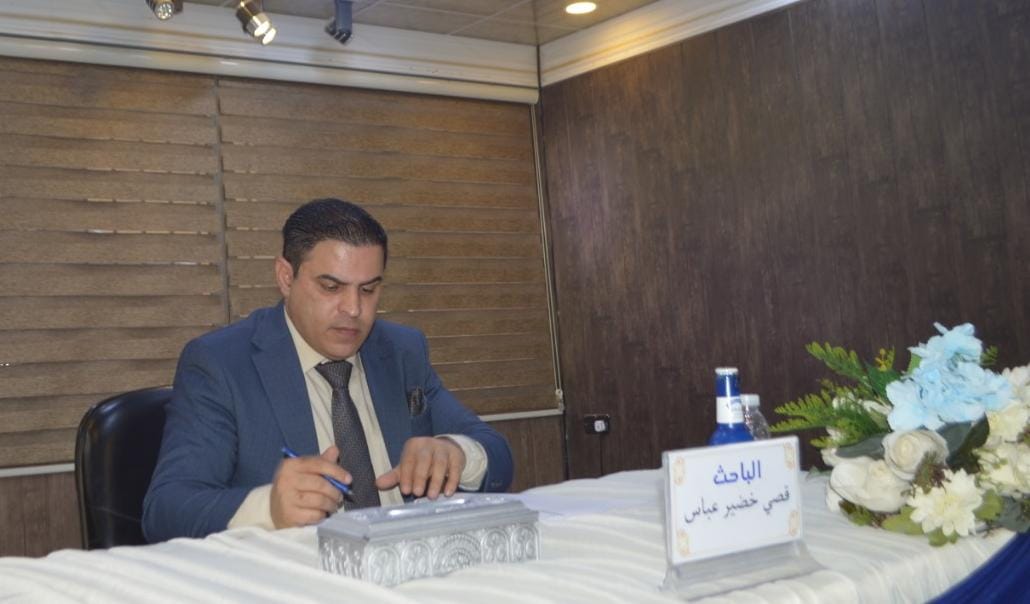
The thesis of master student Qusai Khudair Abbas discussed laser applications / biology for his entitled thesis
“Effect of a 532 nm diode laser on Staphylococcus aureus bacteria isolated from burn patients and hospitalized pneumonia”
Where the discussion committee consisted of the professors whose names are listed
1- Prof. Dr. Caesar Nima Mazloum / PhD-laser/ biology/ Faculty of Medicine/ University of Babylon/ Chair person
2- Asst. Prof. Dr. Zainab Fadel Mahdi / PhD in physics – lasers and spectra / Institute of laser for Postgraduate Studies / University of Baghdad / Member
3 – Asst. Prof. Dr. Laila Fouad Ali / Ph.D. Microbiology / biology/ College of Science / University of Baghdad / Member
4- Asst. Prof. Dr. Laila Mohammad Hassan / Ph.D. laser / biology/ institute of laser for postgraduate studies / University of Baghdad / member and supervisor
Where the aim of the study was to evaluate the effect of a diode laser (532 nm) on Staphylococcus aureus bacteria isolated from burns and pneumonia patients.
The idea in this study included that:
Staphylococcus aureus is capable of attaching to surfaces, invading or evading the immune system, and causing serious toxicity to the host due to the presence of several virulence factors. Since the 1920s, S. aureus has been recognized as an important cause of pneumonia in both the adult and pediatric population. In addition to bacteremia after burn injury, it is considered the most important type of staphylococcus because it is the main cause of fatal or severe infection. As new strains of these antibiotic-resistant bacteria are increasingly emerging, it has become necessary to deal with different methods to control this pathogen. One such method is the antimicrobial photokinetic inactivation process using a low-level laser.
One hundred and twenty samples of burns and sputum of patients were taken, ten isolates of Staphylococcus aureus from burn patients, and ten isolates of Staphylococcus aureus from sputum of pneumonia patients were selected for the study. A continuous diode laser with a wavelength of 532 nm was used, with an output power of 80 mW, a power density of 0.1 W/cm2, the beam diameter was 1 cm, and the exposure times were varied (1,2,3) minutes to obtain different doses (12.22,6.1). and 18.34) J/cm2. In addition, rose petal was used at a concentration of 100 μg/mL. The working method consisted of two parts, as follows:
1- Irradiation with a diode laser without rose bungal
1 ml of a 1*5-10 bacterial dilution is placed in each Eppendorf tube and exposed to diode laser light at different exposure times (1,2,3) minutes (except one of these tubes was not exposed to laser light in order to keep it as a control), and force density 0.1 W/cm2 and dose (12.22,6.1 and 18.34) J/cm2, respectively, then the bacterial suspension was cultured in Eppendorf tubes on nutrient agar and aerobic incubation for 24 hours. The colony-forming unit (CFU) (this represents the surviving colonies) was enumerated, and virulence factors were tested.
2- Diode laser irradiation with rose bungal
0.5 mL of Rose Pinkal, at a concentration of 100 µg/mL was added to 0.5 mL of a bacterial dilution of 1*5-10 to obtain a final concentration of 50 µg/mL. All of these were exposed to laser light at different exposure times (1, 2, and 3) minutes, except for one Eppendorf tube that was not exposed to laser light (containing a photosensitizing bacterial suspension (Rose Bengal)) to serve as a control. All bacterial suspensions in all tubes (exposed and unexposed) were cultured on nutrient agar for 24 hours at 37 °C in an air container, then the colony-forming unit (CFU) was enumerated, and virulence factors were tested. The results of the laboratory study included two parts
First, Bacterial isolates were exposed to one type of low-level laser light (diode laser) to determine the effect of the laser on Staphylococcus aureus.
The results showed that doses (6.1 and 12.22) J/cm2 of diode laser without photosensitizer had no significant effect on the vitality of S. aureus cells, while at higher doses (18.34 J/cm2) a decrease in the number of colony-forming units was observed. In the presence of the photosensitizer (Rose Pinkal), a significant effect of killing Staphylococcus aureus was observed at all doses.
Second, bacterial isolates were exposed to low-level laser light (diode laser) to determine the effect of the laser on S. aureus virulence factors.
The results showed that doses (6.1 and 12.22) J/cm2 of diode laser without photosensitizer did not affect the virulence factors of S. aureus cells. In contrast, virulence factors decreased at higher doses (18.34 J/cm2). In the presence of the photosensitizer (rose petal), a decrease in virulence factors was demonstrated at all doses.
It was concluded that the diode laser with a wavelength of 532 nm in the presence of the photosensitizer (Rose Pinkal) is a useful tool for killing Staphylococcus aureus isolated from burn patients and pneumonia and reducing pathogenic virulence factors.
Among the most important recommendations of the study,
1- Studying the molecular aspects of the effect of laser + Rose Bengal on bacteria.
2- Studying the long-term effects of laser + Rose Bengal on bacteria.
3- Studying the effect of photosensitizers and other lasers on the virulence factors of bacteria.
4- Studying the effect of photosensitizers and other lasers on the virulence factors of bacteria on animal wounds.
The researcher obtained a master’s degree with the grade ((excellence)) due to his real efforts in preparing the thesis.
